Really Easy Childrenspen and Ink Drawings of Lion

ART | ILLUSTRATION | ANIMATION
Vered Eliezri Ganchrow
For more details and
a Quotation
Children's Book Illustration
By Vered Eliezri Ganchrow
Illustration and text can interact to create a wonderful synergy which is thought provoking, inspiring and illuminating, especially when they are optimally laid out on the pages of children's books.
Every child loves to hear a story. A good story carries ideas, images, feelings and encourages development. A good children's book connects the child to reality, makes fantasy accessible and creates a dialog between them. But – is it good to have children's books illustrated? Children have a vivid imagination – so shouldn't we leave them to their own imagined world? I think that illustrating children's books is good, since the joining of text and imagery expands the myriad possibilities of realization. It is important to expose the child to a variety of stories as well as to a variety of illustration styles in children's books. For children, text and illustration are received with equal intensity and are not perceived separately, rather as one. Just like every child fully accepts that dragons eat porridge or clouds bring rain down into a teacup. The text feeds the narrative and the illustration engages the senses. The attention to color, line, and materiality present the young reader with qualities to receive, absorb and enrich the reading experience.
This is where the illustrator's work begins. Before starting to illustrate a text , I converse with it, expand the narrative and play with the ideas. Although the illustration is often a visual depiction of the text content it often leads me to unfurl it, interpret it to my own liking, joke and riddle with it, while still leaving space for imagination. To me, a good text is a text that I can journey with.
Illustrating Children's Books - Styles, Techniques and Materiality
Every story has its own feel which can be enhanced by choosing the right illustration style to accompany it , to augment the reading experience. Following is an overview of several illustration techniques, styles and the materiality which they offer. I will detail how these illustration techniques work and suggest how to best match them with the corresponding narrative to achieve the desired results
Watercolors in Children's Books Illustration
Water colors, for me, create a lyrical feeling, fairytale-like, and bring a lot of air and breath into the illustration. Watercolors make it easy to create depth and use many subtle hues. Drawing with watercolors requires a high level of planning due to the need of working with transparencies necessitating patient work moving from light layers to darker ones. You can combine pen and ink lines with watercolors. There are many classic illustrated children's books using water colors which are usually "warm" illustrations that evoke a sense of journey in a sweeter and softer world than ours.
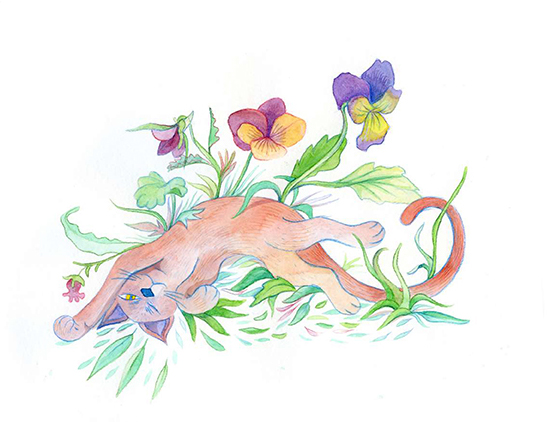
Soul Love by Tamar Nethaniel, Illustrated by Vered Ganchrow, 2020. Water Colors
Monochrome Illustration of Children's Books
Black and white drawings stimulate imagination and can bring a lot of creativity although these are not regularly found in younger children's books and are more suited for older children or teenagers. Usually, child literature which survived the test of time from periods when only monochrome press existed, both in text and illustration, are considered high-end literature. Critics and curators of older children's literature love monochrome illustrations.
I wonder what children prefer.
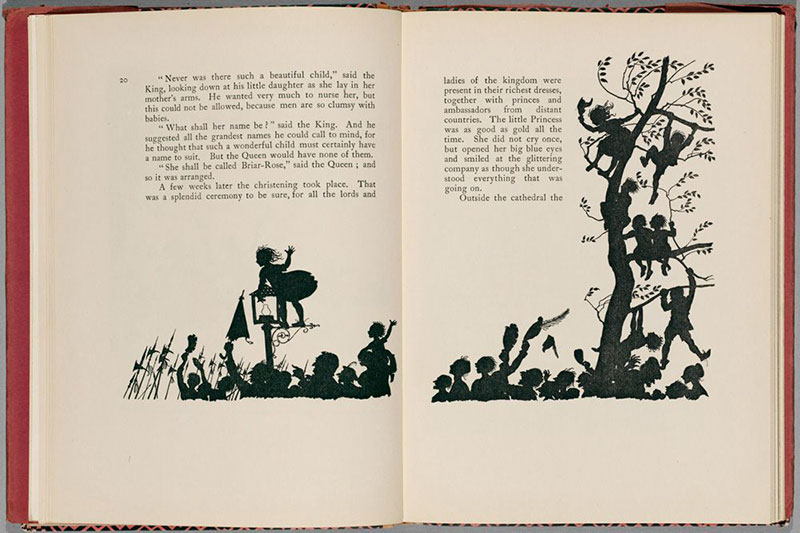
The Sleeping Beauty written by C. S. Evans illustrated by Arthur Rackham, 1920. Ink
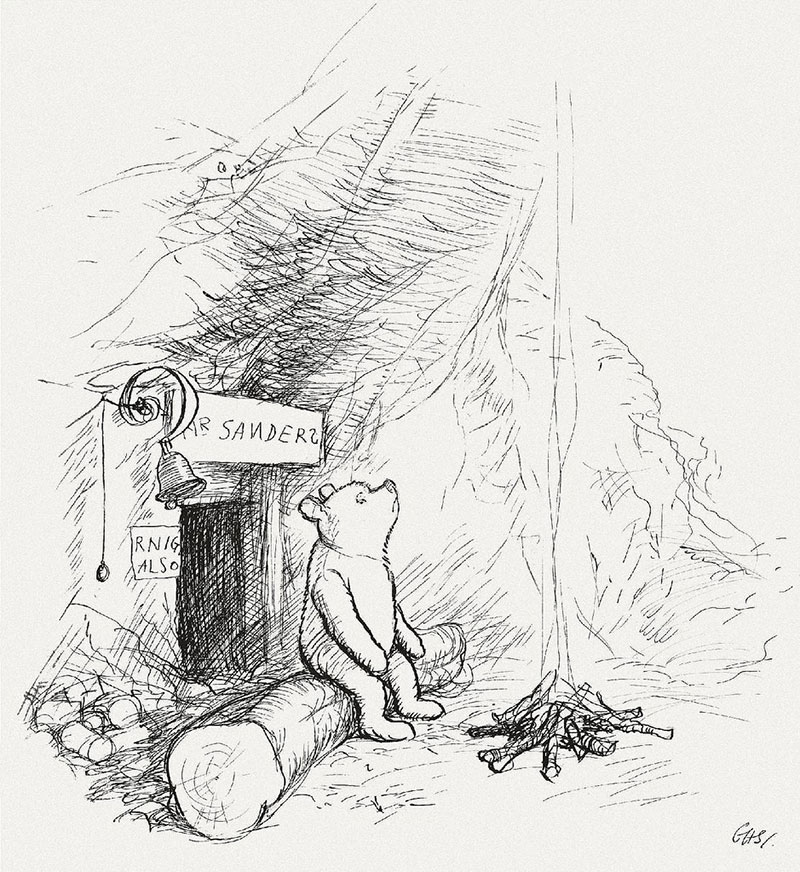
Winnie the Pooh, written by A. A. Milne illustrated by E. H. Shepard 1926Pencil and ink
Children's Books Illustration in Pen and Ink.
Illustrating children's books with pen, ink and brush requires a high level of technique. Often increasing the legibility of the illustration counteracts a more abstract narrative. Colored pens are used to create illustrations with clear contours. Since the color is indelible, illustrators take advantage of this quality to draw quickly. Colored ink produces transparencies and layer work with saturated colors and sharp hues.
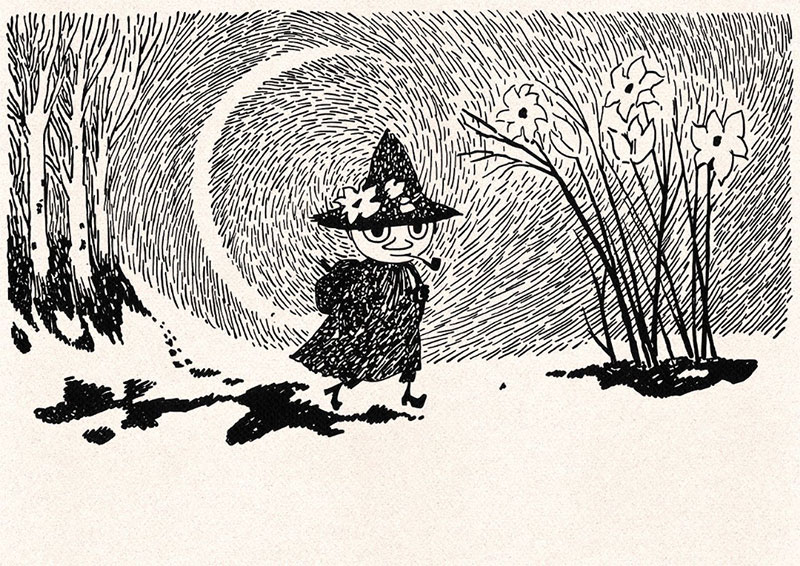
Moominvalley in November, written and illustrated by Tove Jansson, 1970.Pen & Ink
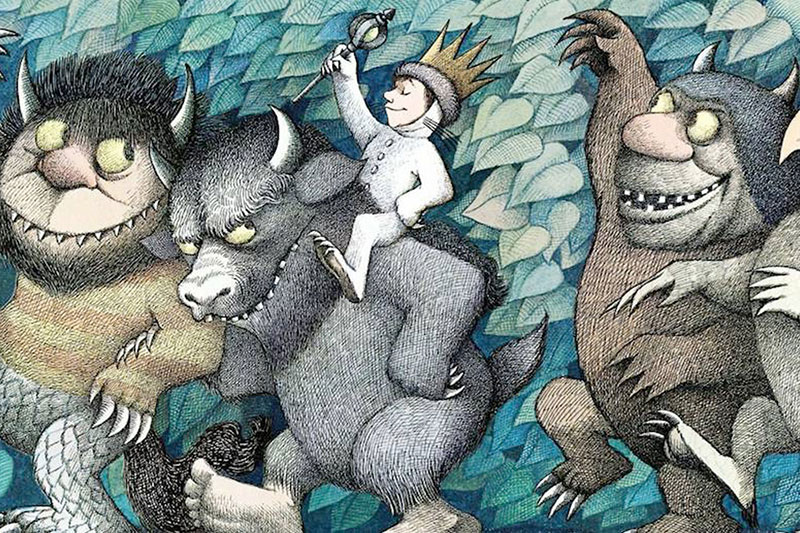
Where the Wild Things Are written and illustrated by Maurice Sendak, 1963. Pencils, coloured Pen and Ink
Illustrating Children's Books with Colored Pencils
Colored pencils are primary, accessible and casual. They immediately impart a notebook feel, like an illustration doodled while writing the story, sketchlike. Often it is the voice of the "the child" in the story, since the means of the child to explain him\herself fits a easygoing notebook style drawing. Sometimes the illustrator "becomes childish" and emphasizes the childlike style. So interestingly enough, at the same time, colored pencils can create high quality illustrations or drawings ( such as scientific botanical illustrations) but can also be used to visually represent any fantasy .
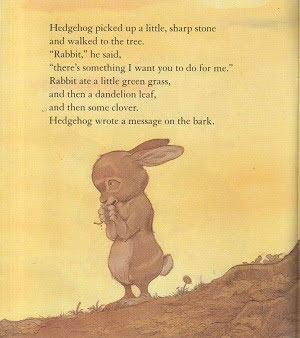
A little bit of winter by Paul Stewart and illustrated by Chris Riddell, 2000. Pencil, Watercolours.
Illustrating Children's Books with Dry Pastels and Oil Pastel Colors
Oil Pastels have a rich, intense, diverse colorfulness. They are readily available for children and since most children had experience drawing with them.
Dry pastels allow greater softness, subtlety and detailing. Dry pastels are perfect for blending colors due to their dusty texture which allows mixing colors together to achieve the desired softness.
Illustrating Children's Books with Oil / Gouache / Acrylic
This is an opportunity to bring into the pages of the book an abundance of color, paint brush strokes, strong expression and powerful pigment combinations.
Oil paints can tell a whole story through the strong material presence in the spaces between the subjects, objects, and the portrayed scenery. Oil paints require skill and time, but can bring softness and fullness which is suitable for covering large areas, depending on the illustrator's style. When printing oil paint illustrations, in order to ensure high fidelity to the original illustrations that have a 3D materiality, printing quality settings should be of
the highest quality. I feel that oil painting best portrays landscapes and scenes of great vastness.
Nothing can beat the bold and vivid multicolor provided by acrylic paint. The fast drying time and the wide variety of available colors makes acrylic paints the perfect fit for many artists and illustrators worldwide. Gouache works similarly but feels like it has less pigment saturation. Illustrating with acrylic paint is quicker than oil paints; allowing to easily add pencil lines or collage parts and to meet work deadlines. Acrylic paint covers large areas and is voluminous and substantial like oil. Therefore, high printing quality is similarly required in these kinds of reproductions.
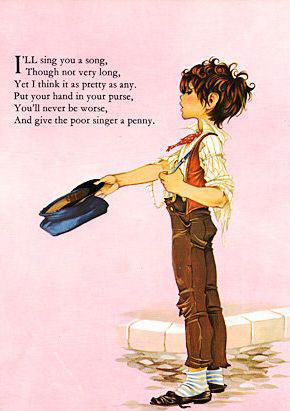
Dean's Gift Book of Nursery Rhymes, illustrated by the twin sisters Janet and Anne Grahame Johnstone, 1965.
Gouache on Board
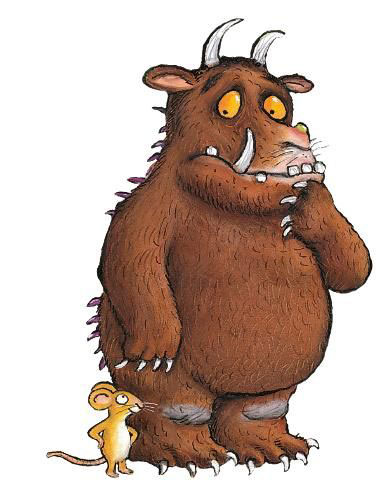
The Gruffalo by Julia Donaldson illustrated by Alex Scheffler, 1999
Colored Ink and maybe acrylic
Illustration of Children's Books by Printmaking
Since the appearance of print, various printing techniques emerged for preparation and replication of illustrations for children's books. Among these are etching, woodcutting, engraving, lithography and silk-screening. Each requires a specialization in the process, applying suitable colors, choice of material and use of presses / screens and other accompanying equipment. Nowadays, these printing techniques usually require the artist to have access to specialized equipment, hence less practical for small projects or tight schedules.
However, the outcomes are so rewarding that if at all possible, you should just go for it!
Imagination is my Dog, by Vered Ganchrow 2021, Silk-screening for a limited edition of 18 copies, produced by the 'Jerusalem Print Workshop'.
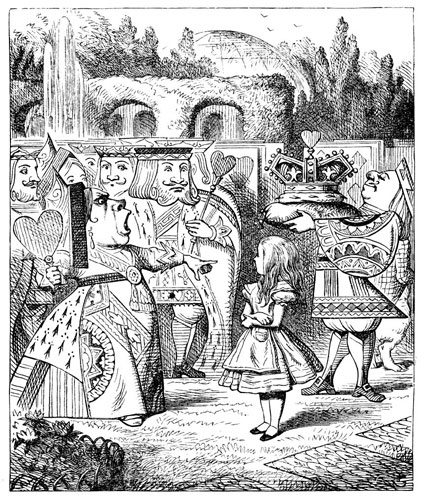
Alice's Adventures in Wonderland, by Lewis Carroll, illustrated by John Tenniel, 1865. Off with Her Head!""
Wood engraving
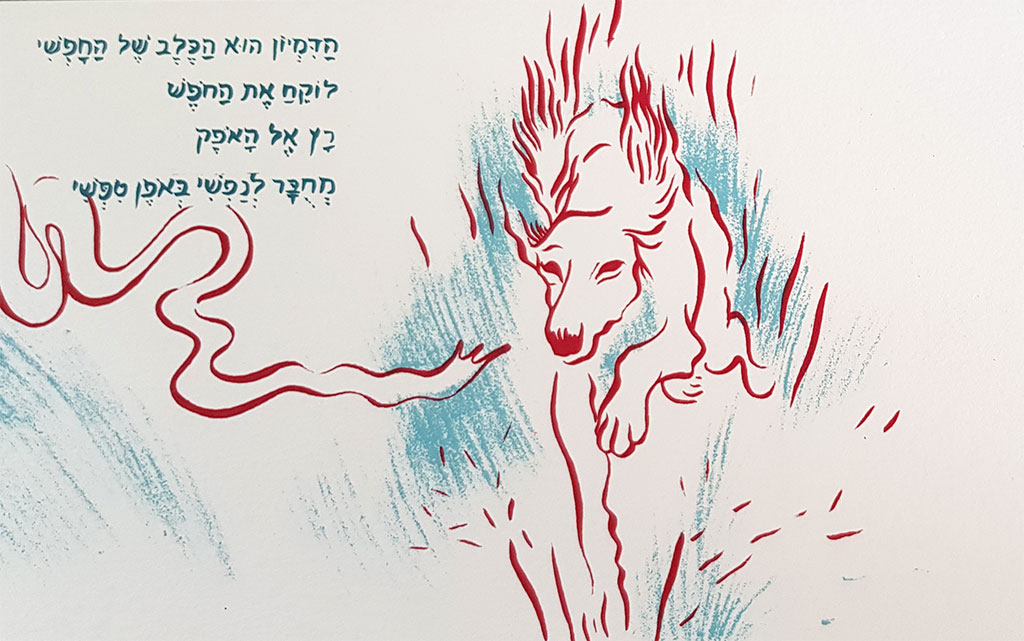
Imagination is my Dog, Poem and Illustration by Vered Ganchrow 2021. Silk screen and hand bound limited edition produced by the Jerusalem Print Workshop.
Illustration of Children's Books by Collage / Assemblage
Collage and assemblage are both compiled of commonly found materials, the difference being that assemblage incorporates three dimensional objects whereas a collage is composed of mostly two dimensional cuttings (usually paper).
These techniques open things up for playfulness and endless improvisation. Printed matter can be combined with familiar items (ready-made), and drawings can be added into the collage itself. Many children's collages that I've seen are made tastefully and arouse the entertainment buds. On the other hand, I have observed that many children do not enjoy collages as much as I do. The collage brings in complexity and additional context that requires a level of image decoding which may be too complex for some children.
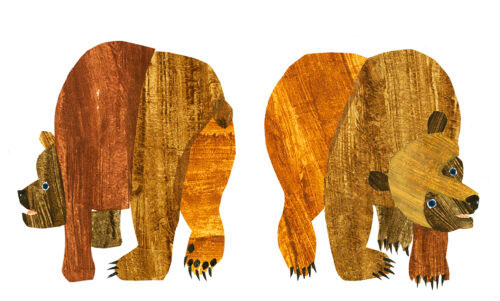
Brown Bear Brown Bear What Do You See? by Bill Martin Jr.illustrated by Eric Carle, 1967.
Collage
Computerized Illustration of Children's Books
Very popular and common. Computerized drawing tools can look like or even be indistinguishable from many of the classical techniques of illustration and it is easy to combine between them which simplify the work of the illustrator. There are many illustration programs that enable a graphic look that is unlike familiar materials. These programs are powerful illustration tools: allowing faster than ever drawing, multi-version saving and error correction. Since each illustrator uses these tools differently and the possibilities are endless a critical eye is needed. As readers and observers we should be aware whether we are captivated by an illustration or whether the technique obscures the art and soul of the image.
Figure 2 – The Horse Fairytale, Illustration by Vered Ganchrow, A popular tale for a Positive Thinking booklet by Meitav Publishing, 2016
Illustration of Children's Books with Mixed Techniques
Each illustrator chooses which mix/ hybridization of techniques suits them, something that enables to fine tune his\her personal style. For example, it's really fun to mix watercolors with pencils. Water colors provide freedom and serendipitous accidents while pencils provide lines and precision. Take marker pens combined with acrylic – marker pens tire easily of coloring large areas and tire the eyes, whereas acrylic paint can comfortably fill large patches. Other examples are ink drawings combined with paper scraps, pencils with gouache and even sewing stitches . Use this with the never ending possibilities of computer programs and get revolutionary results!
The Future of Illustration of Children's Books is Bright and Colorful
The evolution of the e-book – predicted by experts to bring the demise of the paper publishing industry – didn't erase the need to page through illustrated children's books. The latter are a product of deep artistic, literary and editing processes. Their cultural meaning has withstood the test of time and remains relevant for every child.
Each technique holds its special magic and attributes. If the illustration is compelling, material, intriguing and communicative it starts a conversation with the observer. Beyond choice of technique of course, it is the mutual complementing of the illustration and text as well as the dialog created between the text and illustration that is the main cause of the book's success.
The more the digital world matures; the visual imagery continually becomes more dominant and central in our collective consciousness. The illustrated book will continue to incite, inspire and illuminate. Writers and artists will continue to find new and exciting ways to collaborate and transfer the fruits of their imagination to the page, and the techniques to do this will continue to deepen and grow.
The paperback medium will continue to mature and redefine itself, evolve and thrive.
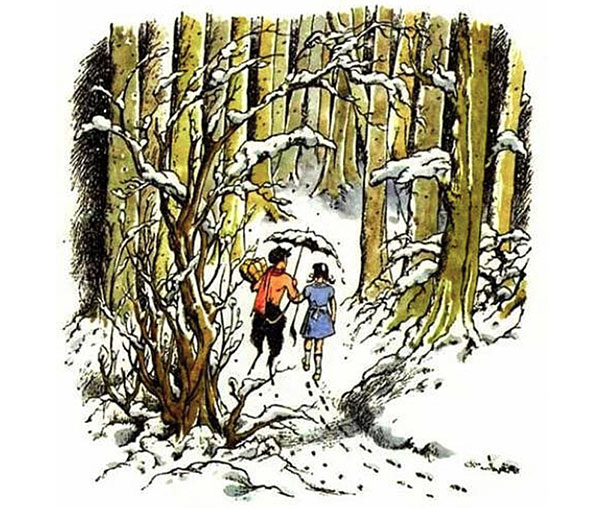
The Lion, the Witch, and the Wardrobe, Narnia series,
written by C.S. Lewis illustrations by Pauline Baynes, 1950.
Lucy and Mr. Tumnus walking under an umbrella in a snowy fairyland.
Ink and watercolors
By Vered Eliezri Ganchrow
Feel free to share the post:
briscoebetimesely.blogspot.com
Source: https://veredgan.com/en/blog-en/childrens-book-illustration-blog/
0 Response to "Really Easy Childrenspen and Ink Drawings of Lion"
Post a Comment